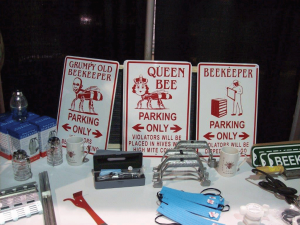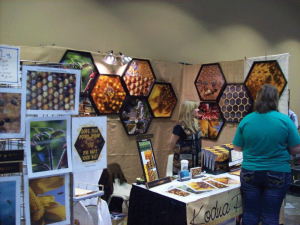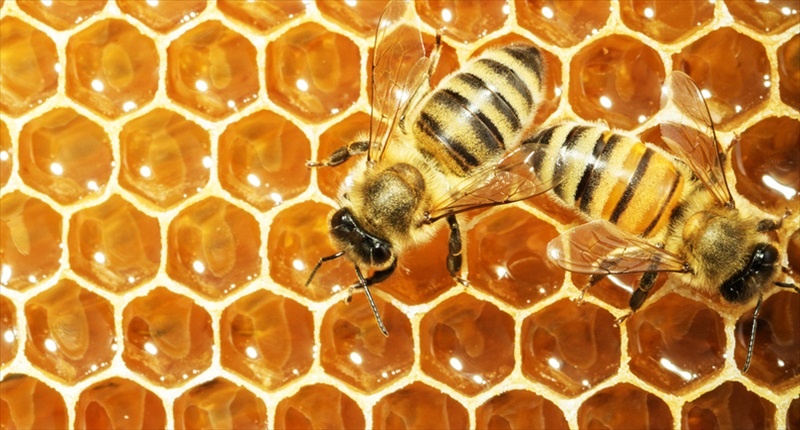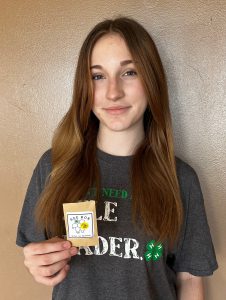
Get in Touch
ahworkerb@aol.com
by- Ann Harman
Beekeepers are inventors and frequently make various items to make keeping bees easier. Some beekeepers love to collect books about bees and beekeeping. Honey bees inspire crafters who create bee-themed quilts, pottery and jewelry. All these items enrich a vendor area at a meeting.
You have set up your bee-related sales display at local meetings and have had enthusiastic buyers. Perhaps now is the time to graduate to larger meetings. State meetings frequently have vendors and the three regional associations, Eastern Apicultural Society (EAS), Heartland Apicultural Society (HAS), and Western Apicultural Society (WAS), encourage vendors whether large equipment supply companies or individuals with bee-related items. The two national conferences American Beekeeping Federation (ABF) and American Honey Producers Association (AHPA) also have vendors. Where to start to be a vendor at one of those?
 You can do much groundwork with the internet. So be prepared to spend some time to find the information you need. Does your state association have vendors at the meetings? There would be an excellent place to start. If vendors have not been a part of your state association meetings, then perhaps now is the time to suggest vendor participation to the association officers. Vendors, whether large equipment suppliers or small crafts people, do enhance a meeting.
You can do much groundwork with the internet. So be prepared to spend some time to find the information you need. Does your state association have vendors at the meetings? There would be an excellent place to start. If vendors have not been a part of your state association meetings, then perhaps now is the time to suggest vendor participation to the association officers. Vendors, whether large equipment suppliers or small crafts people, do enhance a meeting.
Some associations may have vendor coordinators. These are the people who are discovering what facilities the meeting venue has. They will be planning how many of what size spaces the vendors need and are working with the conference organizers on the financial part of having vendors. Each venue is different – size, arrangement of meeting rooms, available space, security of areas, ease of access, availability of tables and chairs, costs and many other details.
It is always a big help if an association has a vendor coordinator, especially one who has done the planning each year for a number of years. Different people reinventing the wheel for each meeting frequently leads to confusion, something falling through the cracks, and general unhappiness on the vendor’s part. Therefore your first step is to inquire from one of the association officers whether vendors are welcome and if there is a vendor coordinator. If so, then you may be in good hands. If not, then perhaps you can contact a vendor from a previous meeting to find out how to proceed.
Right now, October 2016, the only regional association that has a vendor coordinator is HAS, whose vendor coordinator is Dawn Feagan, contact information at d.feagan@hotmail.com. The other two, EAS and WAS, may have a coordinator in the future so keep asking if you plan to attend. The two national ones have vendor coordinators. For ABF you can contact Regina Robuck, contact information rrobuck@meetingexpectations.com and for AHPA contact Cassie Cox at cassie@ahpanet.com.
If you are used to a free space with a table and chair at a local meeting and as many tables and chairs as you want, you may be surprised when applying to be a vendor by a fee for a set space and exactly what will be provided. Not all venues are free for association meetings. The association may very well be charged by the space required, for the number of rooms, and even for tables and chairs. Sometimes an association charges a fee as a means of increasing the club’s income. As a vendor there is no need to get involved with setting fees. Just be certain you understand exactly what space and items you are allotted. If there are separate fees for tables or chairs or other items you can certainly ask if you can bring your own. Don’t grumble if the answer is ‘no.’
 Tables seem to come in all sizes. Many places are now using the lightweight and sturdy plastic ones. Although the six-foot tables seem to be the most common, you could encounter five-foot ones and even eight-foot ones. You could also find various sizes of ‘ancient’ tables, perhaps plywood tops with blobs of equally ancient glue, paint and gouges. You, as well as the vendor coordinator, have no choice but to take what the venue has. Some venues, but not all, will have nice table covers that not only cover the top but also go down to the floor on all sides. Always carry your own table cover, just in case you need one. One item to bring with your supplies is some large binder clips – handy for coping with table covers and different size tables.
Tables seem to come in all sizes. Many places are now using the lightweight and sturdy plastic ones. Although the six-foot tables seem to be the most common, you could encounter five-foot ones and even eight-foot ones. You could also find various sizes of ‘ancient’ tables, perhaps plywood tops with blobs of equally ancient glue, paint and gouges. You, as well as the vendor coordinator, have no choice but to take what the venue has. Some venues, but not all, will have nice table covers that not only cover the top but also go down to the floor on all sides. Always carry your own table cover, just in case you need one. One item to bring with your supplies is some large binder clips – handy for coping with table covers and different size tables.
It’s very simple to make your own table cover. An old bed sheet will not do – it will always look like an old bed sheet (not a good image for your display). Pay a visit to a fabric shop where you might find a bee-related fabric. A tablecloth is very useful but probably will not go down to the floor at least in front and sides. Why does it need to go down to the floor on front and sides? Because nobody wants to see you’ve taken off your shoes and are trying to hide your feet in the jumble of empty boxes, rubbish and a raincoat stuffed under the table.
Some venues offer ‘pipe and drape.’ This is a framework made of pipes on which cloth is hung to make a separation for a given space. Some backdrops are high, others low. Some form sides to the space; others have no sides. Vendors can hang banners on the pipe and drape or fasten something lightweight to the cloth. Usually the pipe and drape is found at convention centers and large hotels. Sometimes colleges have them available.
If you require electricity for your display it may not be available at all venues. Vendor coordinators will have this information as well as any charge for it on their registration form. Sometimes small venues will be in a room with wall outlets. You may need to ask in advance if you need to be near one. Never plan on putting extension cords where someone will trip over the wire. Even if taped down, tape can loosen with many people just walking around.
Always check what the after-hours security will be. Sometimes vendors are put in hallways. If the whole building is secured for the night, that’s good. You want your items safe from theft or just being handled. Bring something to cover your display. Here is where an old bed sheet works just fine. Find out the times the area will be locked for the night and also when it will be open in the morning. You want enough time to have your display ready for sales and your cash box in place.
Yes, you will want some sort of cash box. And have plenty of change. Twenty-dollar bills are common, even for a purchase of $3. But a hundred dollar bill or two are certain to appear. Most people will want to use a credit card, even for that $3 purchase. You will have to decide how or if you will handle credit cards. Some states require vendors to collect sales tax and remit your total collected. Forms for that would be available. You need advance information about any sales tax when you apply to be a vendor in case you need to adjust your prices and also have the right change available.
Do you have a business card or a brochure showing your items? If not, this is the time to have some made. They can help with future sales. However, if you put a pile of your cards or brochures out on the table you can be certain that the ‘collectors’ will take one that will get tossed away sometimes within hours. (These ‘collectors’ walk by all the booths picking up any available card or handout but never actually stop and look at what is being sold.) If a customer stops and looks and even asks questions offer the card and brochure and also tell them you are happy to ship your items if that is possible. It would be nice to get a phone call or email after the conference from someone interested in making a purchase. At big meetings some vendors will have something free on the table – pens or candy are frequent ones. It is a cost for you so you can decide if it’s worth it.
If you are planning to be a vendor at many meetings it might be a clever idea to make a list of the things you would normally bring. Several pens and pencils – never just one. Some paper for making notes. A clipboard can be handy. So is some tape. Although the association may well give their special ‘goody bag’ with souvenirs to attendees, you need to have some bags for your sold items. Some supermarkets will sell you 50 or 100 of their plastic bags, or you can save your own clean ones. If you have fragile items some suitable empty boxes can be useful, as well as bubble wrap and tape.
Your busy times will be in the morning during registration before the program starts, then the break times and the lunch period. A few may come by at the end of the presentations for that day. You may very well have a customer arrive just as you have packed up almost everything at the end of the meeting. You will have to decide whether to dig for the item or not. Just remember to smile. Some associations take good care of their vendors. They are invited to eat lunch early if a box lunch is available at the meeting or if a lunch is served. Otherwise make your own plans to eat early and visit the break area before the time shown on the program.
Should everything have a price tag? If not, you will be answering many ‘how much is this?’ questions. If you buy sticky labels make sure they are labeled ‘removable.’ You can make posters for many situations: items reduced in price, a meeting special, closing time, a new item. However do not make too many posters – many people just do not read them.
Plan your display at home if this is your first meeting as a vendor. You probably know what size table you will have there so find a space that size on a table at home. Decide if you will be standing behind your table then arrange your items. You may not be able to display everything. If the table is too crowded things can be knocked to the floor. Keep in mind that children may find your items interesting. Although the parents are there they are busy deciding to buy something. Various things will get abandoned on your table. Be alert for the half-full coffee cup or bottle of water. The forgotten souvenir bag will probably be retrieved by its owner.
Some customers do not wish to carry their purchase around with them during the day. So they may ask if you would hold it for them. You may not have the space to do that. But if you do, have the customer pay for the purchase and hope they remember to return. Put their name on it in case they forget then you can leave it perhaps at the registration table.
The meeting is over; the vendors have packed up and are leaving. Did anyone tell you where to leave trash and empty cardboard boxes? It is courteous to leave your space clean so seek out the rubbish bins. If they are overflowing you can always take any trash and recycling material home.
Later you will see how successful – or not – you were. Maybe you just broke even or lost a little bit of money. Was it worth it? Yes. Now the beekeepers are familiar with your items and may well buy from you next time. New people come to meetings all the time so there are other possible sales. You have time now to decide if you want to change your display, have more of one item and less of another. Think about what worked and what didn’t. Write it down! Put your comments and ideas in your computer. (It has a better memory than you do.) Now you are ready for the next meeting. See you there!
Ann Harman lives in Flint Hill, Virginia but has travelled all over the country and the world being a vendor at bee meetings. She knows the ropes.









